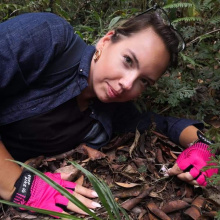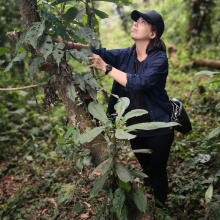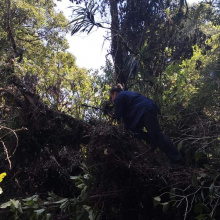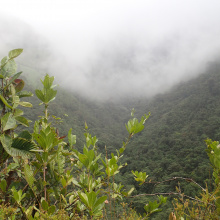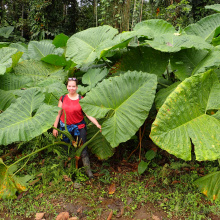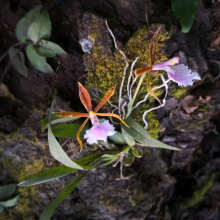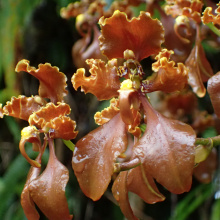
dr Monika Lipińska, photo by Alan Stocki/UG
The scientific interests of dr Monika Lipińska from the Laboratory of Plant Taxonomy at the Faculty of Biology, UG, revolve around the orchid family, and her research is aimed at learning and better understanding the taxonomy, biology and ecology of tropical orchids. Guatemala, Ecuador, Colombia and Indonesia are just some of the destinations of her scientific expeditions. These have resulted, among other things, in the description of approximately 25 orchid species new to science.
Elżbieta Michalak-Witkowska: - When I look at the photos from your field expeditions, I see a passionate woman who enthusiastically travels countless kilometres, constantly looking for... Well, exactly - what? New, previously undiscovered plant species of the orchid family?
Dr Monika Lipińska: - New species too, it might seem that this is the most interesting part of our work. However, this is not the case at all - in recent years I have been focusing more on the relationship between orchids and their pollinators. I am looking for answers to questions such as who pollinates a particular flower and why? We are all rather aware that the biological wealth of the tropics still hides a mass of undescribed species. However, few are aware that, for example, in the case of most described tropical orchids, we do not know who pollinates them. Such research is extremely tedious and time-consuming, so it is safe to say that few scientists choose to devote themselves to this subject. And it is a key element of effective biodiversity conservation - modern conservation plans, to be effective, must also take into account biological networks (including pollinators).
- Why exactly did orchids steal your heart?
- I could, of course, say that they are extremely interesting and beautiful plants. However, the truth is that I came to the Biology Department with a dream to study marine mammals. At the end of my Bachelor's degree, I came into possession of a white Phalaenopsis orchid by accident, and then it was just downhill from there... My home collection at its peak included more than 100 species. It was around this time that I was offered the opportunity to work with prof. Szlachetko. Since then orchids have become a permanent feature of my professional and private life - I have established the Polish Orchid Association foundation, became a delegate in the European Orchid Council and organised the largest international orchid exhibition in Poland three times.
- You say that you focus your research on learning and better understanding the taxonomy, biology and ecology of tropical orchids. Tell us more about that.
- I mainly study orchids of the neotropical subtribe Maxillariinae, but not exclusively. The Maxillariinae is an extremely rich and diverse group (with about 1000 species), and it is also a rather controversial entity. While the taxonomy of this group is an object of debate, its pollination biology remains little explored - so I have a huge amount to learn. Research on the orchid flora of Guatemala is also extremely important to me. Guatemala is a much smaller country than Poland, yet it is home to more than 1,200 species of orchids (compared to only 50 in Poland). Interestingly, it was in Guatemala that I made one of my most interesting discoveries during a lunch break - I observed, for the first time ever, the pollination of two species and a (then undescribed) hybrid of the genus Masdevallia by tiny flies of the genus Zygothrica, which, as a result of research conducted with, among others, prof. Wojciech Giłka turned out to belong to two hitherto unknown species. This is a prime example of how little we know about the richness of the tropics.
- So far you have conducted field research in Guatemala, Ecuador, Colombia and Indonesia. This experience must have opened up the field to the discovery of completely new species, previously undescribed in the literature?
- Of course, the expeditions were both a great adventure and a time of scientific harvest. They resulted, among other things, in the description of some 25 species new to science, cataloguing the orchid flora in Guatemala and some groups found on the island of Bali. The great value of these trips was to confront what we know from literature or other scientific sources with reality. Seeing with my own eyes how the orchids I studied grow, learning about their (often surprising) habitats and the threats they are exposed to. However, it is impossible not to mention that this is also a time of character testing. Working in the tropics, we are exposed to the strangest contingencies - such as spending the night in an Ecuadorian forest without any equipment, a car breakdown in the middle of the forest, or a traffic jam caused by the march of llamas. It has also been invaluable to establish relationships with local researchers and enthusiasts, from whom I often get, for example, photos of potentially new species, locations or other material.
- Your very big achievement was also the confirmation of the hypothesis of orchid pollination by birds. Scientists had been trying to prove it unsuccessfully for more than half a century.
- In fact, the confirmation, after more than 55 years of speculation, of the occurrence of ornithophily in representatives of the subtribe Maxillariinae can be considered one of my most important achievements. It had been suspected for years that some representatives of the Maxillariinae might be pollinated by birds (hummingbirds), but this speculation was based either solely on the results of micromorphological analyses or the few field observations of undefined Maxillaria species (Maxillariinae).
Orchidaceae are fascinating in many ways. They are one of the most advanced plant groups in terms of adaptation to different forms of zoogamy and are renowned for their wide variety of pollination syndromes. Specific traits such as flower morphology, colour, nectar production or the presence of scent are considered decisive for suitability for pollination by different animal groups. However, without field observations, even the most accurate laboratory results remain mere speculation.
- You were also the first to point out the possibility that the orchid Brasiliorchis schunkeana (the so-called black orchid) is pollinated by flies.
- This is, so to speak, a continuation of my earlier research. Brasiliorchis schunkeana is endemic to the state of Espírito Santo in Brazil. We were able to identify pollination of this species by flies (sapromyophilia) as the most likely pollination syndrome and demonstrate the presence and high concentration of two active substances of medicinal (biocidal) importance. The results of this study were published in the prestigious journal BMC Plant Biology and represent the first indication of the possibility of pollination of representatives of Maxillariinae by flies.
- You and your team of researchers have produced an overview of the active substances detected in the flowers of Maxillariinae. Have you been able to discover any medicinal properties of these plants?
- Yes. This was achieved thanks to the work of the entire team, together with dr hab. Agnieszka Kowalkowska, prof. UG. (Faculty of Biology), dr hab. Łukasz Haliński and dr hab. Marek Gołębiowski, prof. UG (Faculty of Chemistry). It turned out that more than 60 substances found in only 20 species (only that many have been tested so far) have confirmed medical potential, i.e. show antibacterial, anti-malarial or anti-cancer properties. What is more, one such substance in the highest currently known concentration was found in the aforementioned 'black orchid'.
- What project are you currently working on?
- Together with the Planta team (SEA-EU), we are currently working on a project in which we would like, among other things, to answer the question of how environmental factors (including climate change and, to some extent, the associated decline in pollinator numbers) affect floral adaptations. From the pollinator side, the problem has been intensively researched, but data on the subject from the perspective of floral adaptation are practically non-existent. As I have already mentioned in the case of pollination biology of tropical orchids, we still have more questions than answers. This of course has to do with the fact that observations of pollination in the field are extremely lengthy and difficult, resulting in very little data.
- Are you planning any further field trips? Is there anything in particular, in terms of research, that you would like to devote your time and attention to?
- Always! Guatemala has become my second home for various reasons, including personal reasons. I also dream of going to Brazil and developing research on the 'black orchid'. I have not mentioned it before, but we have a reasonable suspicion that necrophagous bees (which feed on carrion and other dead organic matter) may also be pollinators of this species. Virtually nothing is known about their biology and suitability as pollinators, so this is an opportunity to describe a new pollination syndrome and unravel another mystery.
- Thank you for the interview.

